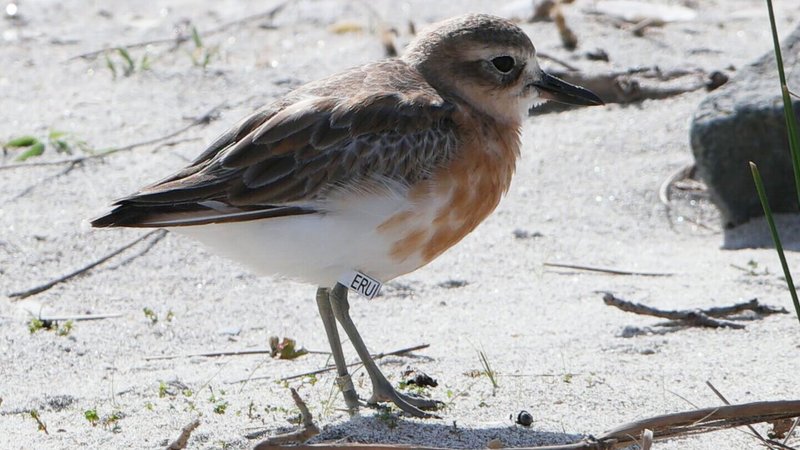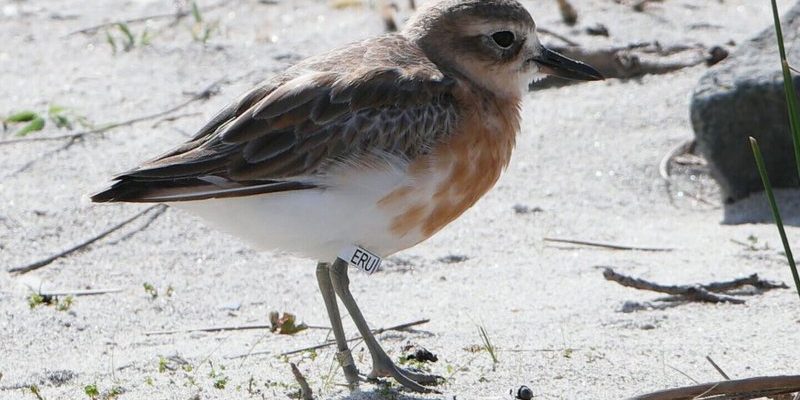
The dotterel is a charming little bird that often captures the interest of birdwatchers and nature enthusiasts alike. Picture this: a small, plump shorebird, dashing across sandy beaches and peeking out from rocky shores. Its lively, quick movements can easily capture anyone’s attention, especially during the breeding season when these birds display fascinating behaviors. With their striking appearance and unique characteristics, dotterels are more than just pretty faces in the avian world.
Known for their distinctive plumage, dotterels change colors with the seasons. During the breeding season, males exhibit vibrant hues that help them attract mates. When they’re not in the mood for romance, they sport more muted tones that blend seamlessly with their surroundings. This clever adaptation not only helps them stay hidden from predators but also makes them a delight to spot for keen eyes. If you find yourself on a coastal walk, keep an eye out; you might just spot one!
Dotterels are not just fascinating to look at; they also play a vital role in our ecosystems. They’re part of the rich tapestry of shorebird life, contributing to the balance of their habitats. Their presence indicates healthy coastal environments, making them important species to study and protect. Understanding the dotterel can give us deeper insights into the health of our ecosystems and the changes they face.
Physical Characteristics
When it comes to size, dotterels are relatively small. They typically measure about 20 to 24 centimeters in length. You might compare their size to a tennis ball—round and compact, making them easily identifiable among other shorebirds. Their wings span about 45 to 50 centimeters, which allows them to take quick, darting flights when needed. With that in mind, let’s delve into their specific physical features.
Their most striking characteristic is their plumage. In breeding season, males sport a rich chestnut color on their upper parts, with a contrasting white belly and a distinctive black line that runs across their breast. This striking pattern is not just for show; it helps them blend into their nesting habitats. On the other hand, females, while still beautiful, tend to have more subdued colors, allowing them to stay hidden while incubating eggs.
Here’s the thing: their short, stout legs and slightly curved bills are perfectly adapted for life on beaches and mudflats. The bill fits right into their diet, which consists mainly of insects, crustaceans, and small mollusks. This unique feeding behavior is fascinating to observe, as dotterels use their keen eyesight to spot their next meal. In short, every feature of a dotterel is finely tuned to help it thrive in its environment.
Habitat and Distribution
Dotterels are typically found in coastal areas, preferring sandy beaches, rocky shores, and mudflats. They thrive in environments where they can forage for food while staying out of reach from predators. As migratory birds, they travel long distances between breeding and wintering grounds. During the summer, you’ll find them nestling in the Arctic regions, including parts of Europe, North America, and Asia. However, come winter, they migrate southward, often reaching warmer coastal areas in Africa, South America, and southern Asia.
During migration, dotterels stop at various locations to rest and refuel. These stopovers are crucial, as they help them regain energy for their long flights. Places like wetlands and estuaries are important habitats that provide the food and shelter they need along the way. As such, protecting these migratory routes and habitats is vital for their survival.
Behavior and Social Structure
When you think of dotterels, you might imagine them dashing along the water’s edge, which is a common sight. These birds are quite social, often found in small groups, particularly during migration and foraging. Their social interactions are fascinating, as they communicate using a range of whistles and calls. Each sound serves a purpose, whether it’s signaling alarm or attracting a mate.
During the breeding season, males perform elaborate courtship displays to woo females. These displays involve running in circles and puffing up their chests, creating an entrancing dance that showcases their vibrant plumage. It’s a sight to behold and essential for reproducing the next generation of these delightful birds. After mating, the female usually lays between three to five eggs in a shallow scrape on the ground, where the couple takes turns incubating them.
After the eggs hatch, dotterels are particularly attentive parents. The chicks are precocial, meaning they are relatively mature and mobile shortly after hatching. They can walk and forage for food almost immediately, requiring their parents to lead them to safe foraging spots. This nurturing behavior is vital for the survival of the young, as they must learn quickly to thrive in their coastal environments.
Feeding Habits
You might be curious about what goes into a dotterel’s diet. These birds primarily feast on invertebrates, including insects, crustaceans, and small mollusks. Their foraging technique is simple but effective; they probe the sand and mud with their bills to uncover hidden food sources. This feeding behavior not only helps them find sustenance but also aerates the soil, benefiting the environment as a whole.
During the breeding season, dotterels require a high-protein diet to support their energy needs. This means they often hunt along the tidal zones, capitalizing on the rich food supply available when the tides recede. Watching them scurry along the shore as they search for food can be quite entertaining; they have a way of moving that evokes a sense of playfulness.
In winter, their diet remains similar, but they may also supplement with seeds or plant material. This dietary flexibility is key to their survival, especially when food sources vary depending on environmental changes. By adjusting their diet to match seasonal availability, dotterels can maintain their strength and health throughout the year.
Conservation Status
Like many shorebirds, dotterels face various threats that could impact their populations. Habitat loss due to coastal development, pollution, and climate change are significant challenges they encounter. As their natural habitats shrink, dotterels are squeezed into smaller areas, making it more difficult to find food and suitable nesting sites.
Several organizations are actively working to protect dotterel populations by advocating for the preservation of their habitats and raising awareness about the importance of these birds. Conservation efforts include establishing protected areas along coastlines, restoring damaged habitats, and monitoring populations to better understand their needs. It’s crucial for everyone to be part of the solution, whether it’s through supporting conservation initiatives or simply being mindful when visiting natural areas.
Community involvement can make a difference! By participating in local birdwatching events or volunteering for conservation projects, you can help contribute to the protection of dotterels and other wildlife. Every little bit helps in creating a healthier environment for these captivating birds to thrive.
Interesting Facts About Dotterels
| Scientific Name: | Charadrius morinellus |
| Weight: | 150-180 grams |
| Wingspan: | 45-50 cm |
| Life Span: | 3-5 years in the wild |
| Breeding Season: | April to June |
| Migration: | Long-distance, wintering in warmer regions |
FAQ
What does a dotterel look like?
Dotterels are small shorebirds with a relatively round body shape. Males are particularly striking during the breeding season, displaying bright chestnut plumage on their backs and a black band across their chests. Females have a more subdued appearance, with browner tones that help them camouflage while incubating their eggs. Both genders have short, stout legs and a slightly curved bill, ideal for probing in the sand for food.
Where do dotterels live?
Dotterels primarily inhabit coastal areas, favoring sandy beaches, rocky shores, and mudflats. They breed in Arctic regions during the summer but migrate to warmer coastal regions in Africa, South America, and southern Asia for the winter. These seasonal shifts are essential for their survival, as they seek suitable habitats based on the time of year.
How many eggs do dotterels lay?
A typical clutch for a dotterel consists of three to five eggs. These eggs are often laid in shallow scrapes on the ground. Both parents take turns incubating them, highlighting their cooperative nature when raising their young. Once the chicks hatch, they are quite precocial and start foraging for food almost immediately.
What do dotterels eat?
Dotterels primarily feed on invertebrates such as insects, crustaceans, and small mollusks. They hunt for food by probing the sand and mud at coastal areas, utilizing their keen eyesight to spot potential meals. Their diet may also include seeds or plant material, particularly during the winter months when food sources vary.
Are dotterels endangered?
While dotterels are not classified as endangered, they do face significant threats that could impact their populations. Habitat loss from coastal development, pollution, and climate change contribute to their vulnerability. Conservation efforts are underway to protect their habitats and monitor populations to help ensure their survival.
How can I help dotterels?
You can help dotterels by supporting local conservation initiatives aimed at protecting their habitats. Participating in birdwatching events, volunteering for restoration projects, and advocating for sustainable practices can make a difference. Every action, no matter how small, contributes to the well-being of these fascinating birds and their environments.
Can dotterels be found in my area?
The presence of dotterels in your area largely depends on your location. In coastal regions, they may be more commonly spotted, especially during migration seasons. If you live near beaches or wetlands, keep your eyes peeled for these charming birds, particularly during spring and fall migrations, when they are more active in search of food and nesting grounds.
What is the dotterel’s breeding behavior?
During the breeding season, dotterels engage in elaborate courtship displays. Males showcase their vibrant plumage and perform dances to attract females. Once mating occurs, the female lays a clutch of eggs, and both parents share responsibilities in incubating them. After hatching, the chicks are relatively independent and begin foraging soon after.
What role do dotterels play in their ecosystem?
Dotterels play an important role in coastal ecosystems. Their foraging behavior helps aerate the soil and maintain healthy habitats for other wildlife. As they consume invertebrates, they also help regulate populations of these organisms, contributing to the balance of coastal ecosystems. Protecting dotterels and their habitats, therefore, is crucial for biodiversity.
Are dotterels migratory birds?
Yes, dotterels are migratory birds! They travel long distances between breeding and wintering grounds. In the summer, they nest in Arctic regions, while in winter, they migrate to warmer coastal areas. This migratory behavior allows them to take advantage of different habitats throughout the year, essential for their survival and reproductive success.

